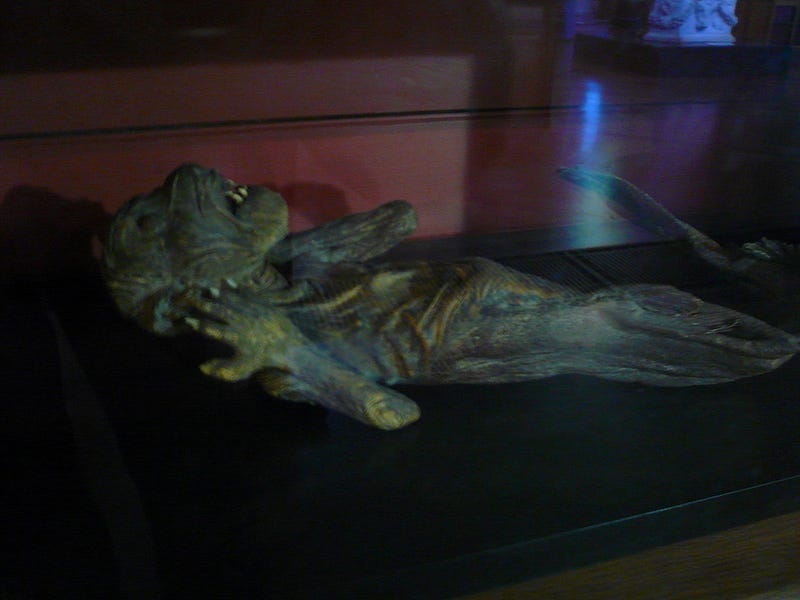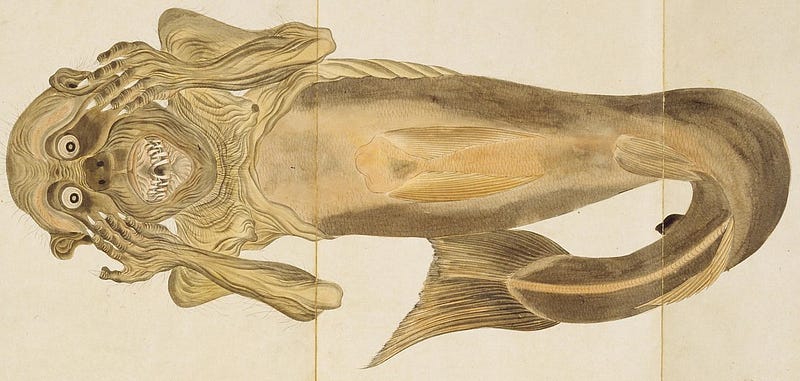Creepy Mermaid Mummy Unveiled: What Scientists Discovered
Written on
Chapter 1: The Mysterious Mermaid Mummy
In Japan, researchers have made significant strides in understanding the enigmatic “mermaid mummy,” a peculiar find believed to be over 300 years old. For months, experts debated whether this creature was a hybrid or merely a clever hoax. Recent studies have finally shed light on its true nature.

[Photo: Ricardo, Flickr, License]
The tale of this mummy dates back nearly three centuries, originating off the coast of Kōchi on Shikoku Island. Scholars have sought to determine if the remains were authentic or merely a fabricated religious artifact. The challenge arose from the fact that these bizarre remains had been stored in a wooden box at a temple in Okayama Prefecture, Honshu Island. Evidence suggested that, in the 18th century, the torso of a monkey might have been sewn together with the lower half of a fish. Historically, mermaids were thought to possess healing powers.
This small mummy measures only 30 centimeters from head to tail and features nails, teeth, and hair, with its lower body covered in scales. In folklore, the mermaid was venerated for its supposed healing abilities. Interestingly, during the first two years of the pandemic, priests at the Okayama temple believed the mummy had curative properties against COVID-19.
Section 1.1: Investigating the Truth
Hiroshi Kinoshita, a member of the Okayama Folklore Society, stumbled upon the mummy while researching mythical creatures. He found references to it in an encyclopedia, which led him to the temple housing this artifact.
According to records found in the box, the creature was allegedly caught by a fisherman between 1736 and 1741, mummified post-mortem, and later sold to a wealthy family. However, the details of how it arrived at the temple remain a mystery.
Kinoshita spearheaded a research initiative, enlisting scientists from Kurashiki University of Science and Arts. Gaining access to the mummy was challenging, but the team used various techniques including CT scans, radiocarbon dating, and DNA analysis to investigate its origins. Kinoshita maintained skepticism about the mummy's authenticity, suggesting it was more likely a product intended for export or ceremonial use rather than an actual biological specimen.
The first video titled "300-year-old mummified 'mermaid' finally explained" offers insights into the recent findings regarding this mysterious artifact.
Section 1.2: The Unveiling of the Mummy's Composition
Further analysis revealed that, apart from the jaw, the mummy lacked a typical skeletal structure. It was determined to be a composite of various materials rather than the remains of two distinct animals. The outer layer consisted of fabric, cotton, and paper, while the head was primarily made of cotton and plaster. This evidence contradicts the notion that the mummy was formed from the remains of two different living or deceased creatures.
However, some animal-like features were indeed present. The lower, fish-like section of the mummy bore scales from two species: blowfish and bulletfish. The nails were formed from a fragment of an unknown creature's horn, and the jawbone likely belonged to a larger fish. Radiocarbon dating indicated that the scales were from the late 19th century, implying that the mummy's creation occurred much later than suggested by the initial documentation.
The second video, "300-year-old 'mermaid mummy' being probed by scientists," provides a closer look at the scientific investigations surrounding this artifact.
Chapter 2: Cultural Significance and Folklore
The mummy bears a resemblance to ningyo, a creature from Japanese folklore that combines features of an ape and a fish. Researchers note that numerous similar artifacts can be found across Japan, particularly in temples and museums, with many dating back to the Edo period (1603–1868).
One of the well-known legends involves Yao Bikuni, a tale about a fisherman and his daughter from Wakasa Province, now known as Fukui Prefecture. The story recounts how the fisherman caught a peculiar fish that had a human-like upper body, leading him to invite friends to share in the meal.
As the tale unfolds, the guests become aware of the creature's human face and refuse to eat, fearing it might be cursed. Unbeknownst to the fisherman, one of his friends inadvertently took home some of the mermaid meat. When he later offered it to his daughter, Yao Bikuni, it set off a chain of events that led her to live an extraordinarily long life, outliving all her loved ones.
The legend of Yao Bikuni quickly gained popularity, leading to a surge in fake ningyo artifacts, as local communities recognized the potential for profit in the myth.

[Photo: Mōri Baien (1798–1851), Public domain, via Wikimedia Commons]
The belief that mermaids possessed healing qualities contributed to their enduring allure, but the rising demand also led to the proliferation of imitations, complicating the legacy of these mythical beings.
The Silent Killer: A Deadly Fungus Takes Over California
America has been grappling with the emergence of the world’s most toxic fungus, the death cap, which has made its way into California, posing a serious threat to public health.
Thank you for reaching the conclusion of this article! Your support is greatly appreciated, so feel free to leave some claps or consider following me. If you found it worthwhile, a tip would also be lovely. Thank you!